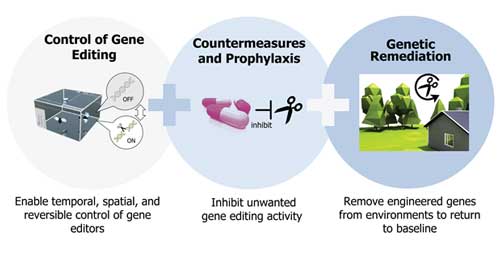| Sep 09, 2016 |
Setting a safe course for gene editing research
|
|
(Nanowerk News) A new DARPA program could help unlock the potential of advanced gene editing technologies by developing a set of tools to address potential risks of this rapidly advancing field. The Safe Genes program envisions addressing key safety gaps by using those tools to restrict or reverse the propagation of engineered genetic constructs.
|
|
"Gene editing holds incredible promise to advance the biological sciences, but right now responsible actors are constrained by the number of unknowns and a lack of controls,” said Renee Wegrzyn, DARPA program manager. “DARPA wants to develop controls for gene editing and derivative technologies to support responsible research and defend against irresponsible actors who might intentionally or accidentally release modified organisms.”
|
 |
| DARPA's Safe Genes program aims to develop a layered biosafety and biosecurity toolkit that will help reduce potential risks and encourage innovation in the field of genome editing.
|
|
Safe Genes was inspired in part by recent advances in the field of “gene drives,” which can alter the genetic character of a population of organisms by ensuring that certain edited genetic traits are passed down to almost every individual in subsequent generations. Scientists have studied self-perpetuating gene drives for decades, but the 2012 development of the genetic tool CRISPR-Cas9, which facilitates extremely precise genetic edits, radically increased the potential value of—and in some quarters the demand for—experimental gene drives.
|
|
Traditional biosafety and biosecurity measures including physical biocontainment, research moratoria, self-governance, and regulation are not designed for technologies that are, in fact, explicitly intended for environmental release and are widely available to users who operate outside of conventional institutions. The goal of Safe Genes is to build in biosafety for new biotechnologies at their inception, provide a range of options to respond to synthetic genetic threats, and create an understanding of what is possible, probable, and vulnerable with regard to emergent gene editing technologies. “DARPA is pursuing a suite of versatile tools that can be applied independently or in combination to support bio-innovation or combat bio-threats,” Wegrzyn said.
|
|
There are three technical objectives within the Safe Genes program. First, develop genetic constructs that provide spatial, temporal, and reversible control of genome editors in living systems. Second, develop new small molecule and molecular countermeasures that provide prophylactic and treatment options to prevent or limit genome editing in organisms and protect genome integrity in populations. Third, develop a capability to eliminate unwanted engineered genes from environments and restore systems to their genetic baseline state.
|
|
From a national security perspective, Safe Genes addresses the inherent risks that arise from the rapid democratization of gene editing tools. The steep drop in the costs of genomic sequencing and gene editing toolkits, along with the increasing accessibility of this technology, translates into greater opportunity to experiment with genetic modifications. This convergence of low cost and high availability means that applications for gene editing—both positive and negative—could arise from people or states operating outside of the traditional scientific community.
|
|
DARPA will host a Proposers Day on September 30, 2016, at the United States Institute of Peace in Washington, D.C., to further clarify the program vision and answer questions from potential proposers. Advance registration is required: http://go.usa.gov/xWvYG. Full program details will be made available in a forthcoming Broad Agency Announcement.
|

